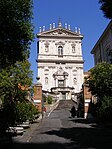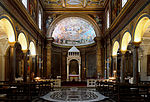Monti (rione of Rome)
Rioni of RomeRome R. I Monti

Monti is the 1st rione of Rome, identified by the initials R. I, located in Municipio I. The name literally means "mountains" in Italian and comes from the fact that the Esquiline, the Viminal Hills, and parts of the Quirinal and the Caelian Hills belonged to this rione: currently, however, the Esquiline Hill belongs to the rione Esquilino. The coat of arms consists of three green mountains with three tops on a silver background.
Excerpt from the Wikipedia article Monti (rione of Rome) (License: CC BY-SA 3.0, Authors, Images).Monti (rione of Rome)
Via di Sant'Agata de' Goti, Rome Municipio Roma I
Geographical coordinates (GPS) Address Website Nearby Places Show on map
Geographical coordinates (GPS)
| Latitude | Longitude |
|---|---|
| N 41.894962 ° | E 12.4892253 ° |
Address
Casa per ferie II Il
Via di Sant'Agata de' Goti
00184 Rome, Municipio Roma I
Lazio, Italy
Open on Google Maps









